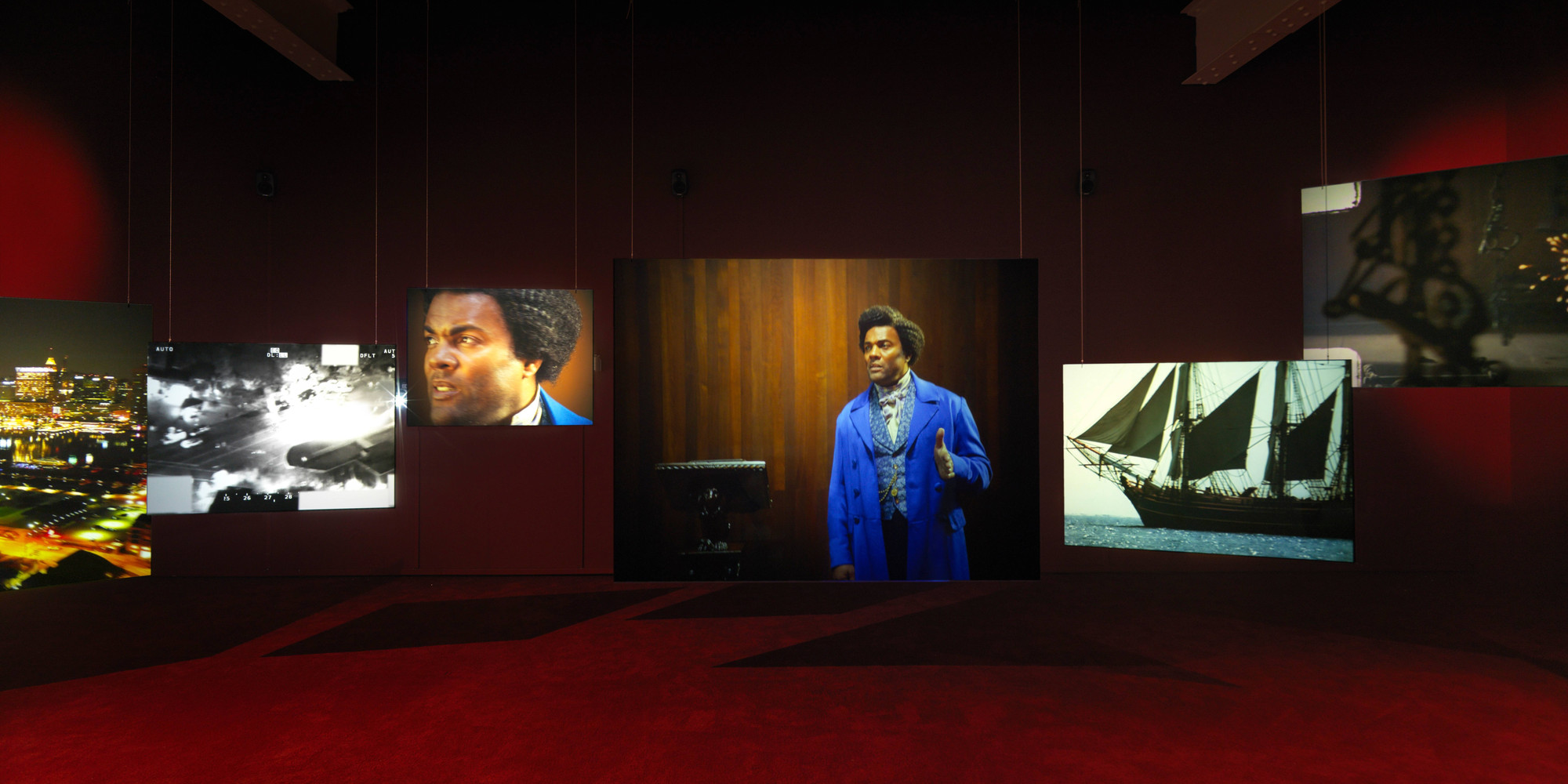
Decoding Douglass: How Isaac Julien Breathes Life into an Iconic Figure
The artist explains how Lessons of the Hour illuminates the legacy of Frederick Douglass and the ongoing urgency of his work.
Sir Isaac Julien, Ugochukwu-Smooth C. Nzewi
Jun 17, 2024
In 2016, the artist and filmmaker Isaac Julien was invited to participate in Reflections on Place, a media arts initiative at the University of Rochester’s Memorial Art Gallery, to celebrate the history and culture of Rochester, New York. Walking through the city’s Highland Park, Julien was drawn to an eight-foot bronze statue of Frederick Douglass, the visionary African American abolitionist who liberated himself from slavery in 1838. It was created by Stanley W. Edwards and unveiled in 1899, four years after Douglass’s death. The sculpture was the first civic monument in the United States to honor an African American, and it sparked Julien’s interest in Douglass. For four years, he studied his subject, reconstructing aspects of his time in Scotland, London, Baltimore, and Washington, DC.
These locations appear in Lessons of the Hour, Julien’s video installation based on Douglass’s life and activism. Presented across 10 screens of varying sizes to suggest the salon-style way of hanging pictures popular during the 19th century, it juxtaposes the past and the present, the archival and the documentary, in bringing its subject to life. Like all of Julien’s films and video installations, Lessons of the Hour is defined by his close attention to historical detail. Using photography and film, Julien animates history by reappraising the lives of historical Black subjects who have been under-recognized or ignored.
On the occasion of Isaac Julien: Lessons of the Hour, and in commemoration of Juneteenth, I spoke to Julien about the motivations and challenges of this project, the history of Black struggle, the relationship between art and activism, and Douglass’s enduring appeal.
—Ugochukwu-Smooth C. Nzewi, The Steven and Lisa Tananbaum Curator, Department of Painting and Sculpture
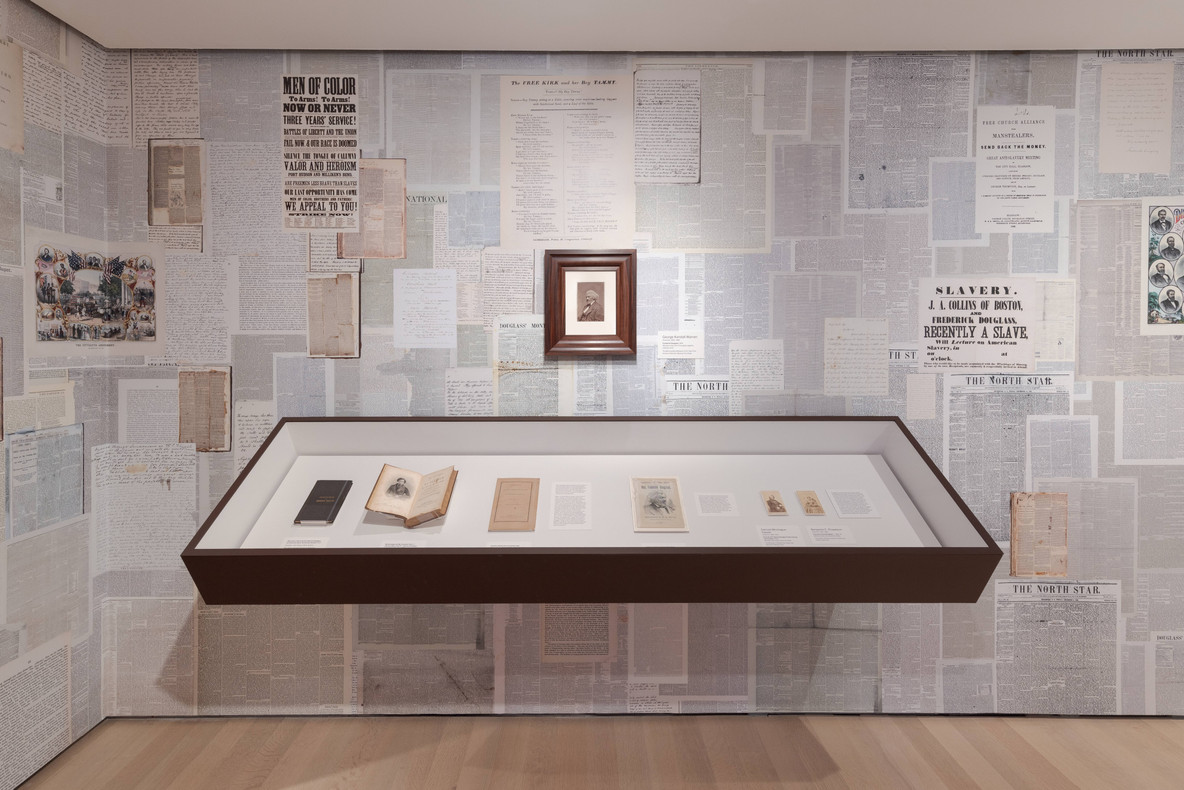
Installation view of the exhibition Isaac Julien: Lessons of the Hour
Isaac, I will start with an obvious question: Why and how did you get interested in making a film about Frederick Douglass, and especially in an expansive way?
As my research into this project grew, I realized that Douglass wasn’t only at the forefront of abolitionism. He also lived in Scotland, lectured on photography, and was a theorist of representation, which I see myself as being involved in through my work. Rochester, where Douglass and his family lived, is the home of Kodak Eastman House and is a center of photography. All of this really drew me to Douglass.
These things were tipping points in relation to the project. A lot of the ideas also developed during the process of making and editing the work. The process became a kind of revelation. These ideas started to percolate and inform one another and the project expanded into this 10-screen salon work.
Douglass is a multidimensional character: an abolitionist, a masterful writer, a gifted orator, and a thought leader. He was someone who made his storied life an example of the many ways to enlighten and instruct, but also used his life and image for racial uplift. How did you decide on your research strategy and cinematic approach to this very seminal figure?
I’ve made biopics before. But because Douglass is such a multifaceted and polyvalent figure, the main thing I was interested in is his writing about photography. That was an avenue that I thought needed to be explored. When I went to his house in Cedar Hill, I could see that he had also been an art collector and seriously interested in art. These things enabled me to paint a picture of Douglass. In some parts, Douglass is portrayed as someone who had been Frederick Bailey, a slave, and it was valuable to have insight into the things that would have haunted him.
I think his time in Scotland was also quite lonely. He was away from Anna Murray Douglass, his wife and a liberator in her own right, and their children, Rosetta, Lewis Henry, Frederick Jr., Charles Remond, and Annie Douglass. In scenes where he’s with his horse, it was important to me to show him not riding but walking with the horse, because I wanted to bring out this aspect of his relationship to animals, and to horses in particular. All of these things came out of research, and they came out because people became enamored with Douglass and were inspired by him.
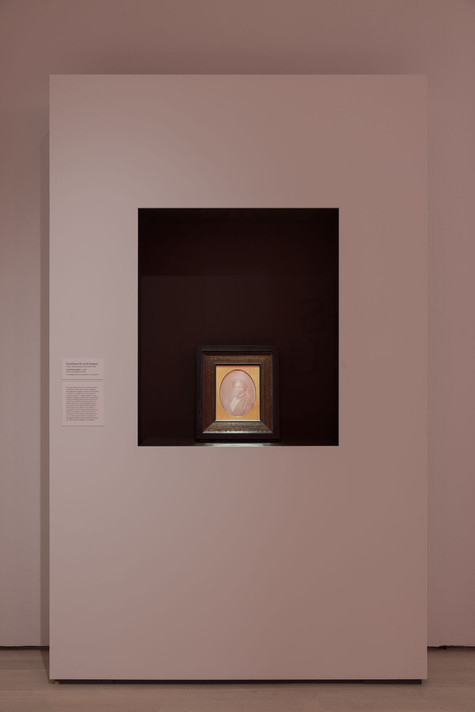
Isaac Julien: Lessons of the Hour
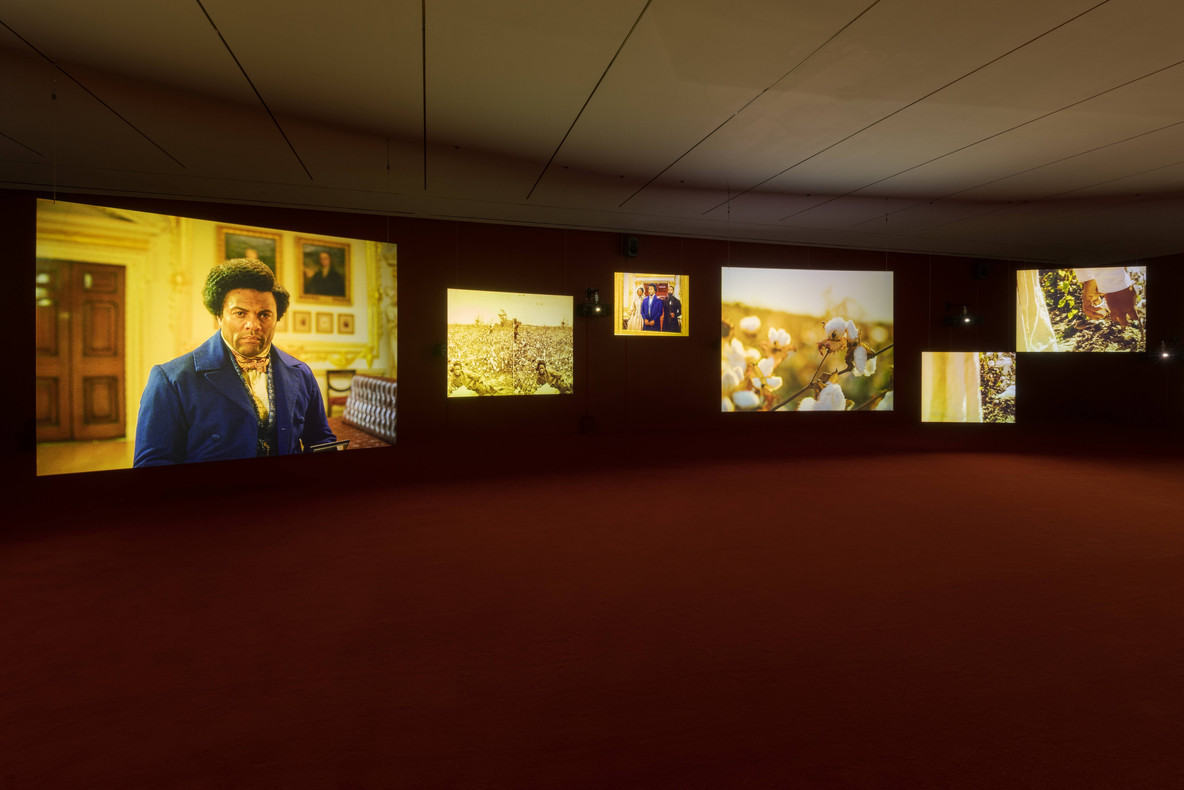
Isaac Julien: Lessons of the Hour
This is the idea that you don’t look at the archive as an absence, but as a space for critical reinvention or re-improvisation.
Isaac Julien
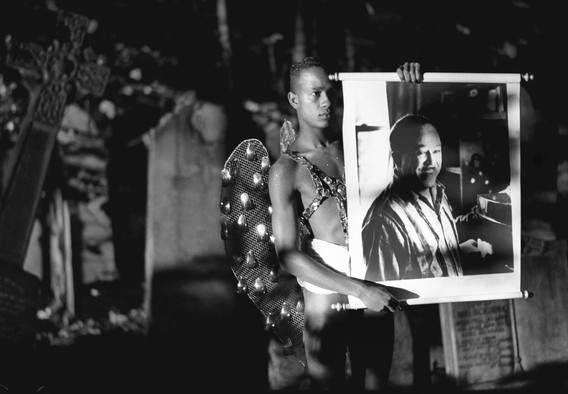
Isaac Julien. Looking for Langston. 1989
“Lessons of the Hour” is the title of arguably the last lecture Douglass delivered, at Washington, DC’s Metropolitan African Methodist Episcopal Church, on January 9, 1894. He passed away about a year later at his Cedar Hill home in Washington, DC. Why did you choose it as the title [of the work]?
It is his last lecture and it explores questions of citizenship and is a declaration of protest against white supremacy. I thought it was important to have this title because, of course, Douglass was alerting us to the lessons of the hour of his moment. But how it resonates today—especially in relation to the ways in which Black Lives Matter and Freddie Gray’s murder in 2015 are still resonating—feels pertinent. Imagining a 200-year arc in relation to these questions moving from Douglass’s time to the present moment suggests that there are still many unfinished dialogues to be had about the question of citizenship.
And, of course, Douglass’s activism was imbued with a particular aesthetic sensibility. He was thinking about the image, thinking about aesthetic questions along with his enormous work of communication. He produced his newspaper, the North Star, but also lecture tours and various writings, all the while picturing himself as the most photographed person of this period.
These are points of reference for our own time: think of the iPhone and its political power. I think this is something Douglass recognized very early on about photography. That is why in the concluding part of the work, where we have the “What to the Slave Is the Fourth of July?” speech, there’s infrared and surveillance footage.
In Lessons of the Hour, there’s a poetic consideration of the boundaries between the fictional and the documentary, and how the two overlap. And one of the things that I have been thinking about is whether the idea of critical fabulation, this notion of speculative retelling of parts of history to fill omissions, as the cultural historian Sadiya Hartman has theorized, is something you considered as a strategy of connecting facts and imagination in this project.
The notion of critical fabulation is something that was being worked out in early films of mine, like Looking for Langston. This is the idea that you don’t look at the archive as an absence, but as a space for critical reinvention or re-improvisation. I like thinking about fiction in this speculative manner, which allows me to improvise and visually speculate. When I’m making the work I want it to be something which is alive to a certain extent, so the imagination becomes a part of it. As in the case of Looking for Langston, this is what I do when there are no representations or an erasure. I like the idea that erasure can be a space for critical and creative reinvention. But I don’t see that reinvention being based on just fantasy. We know, for example, that Toni Morrison worked with fiction, but she worked by doing research and then adding the imaginative aspect.
The color red is so dominant in the work, but also in the ambience of the installation. Can you tease out the symbolism of red both in terms of its historical context and its aesthetic implications?
Red is connected to the fact that this installation is hung in the salon style, the way in which paintings of the 19th century were displayed. And then the way the red emanates from the film itself and the clothes that Douglass wears: he has a red coat at the beginning of the film, where he’s in a forest in autumn. I waited until autumn to film because I wanted to have that sort of color at the beginning.
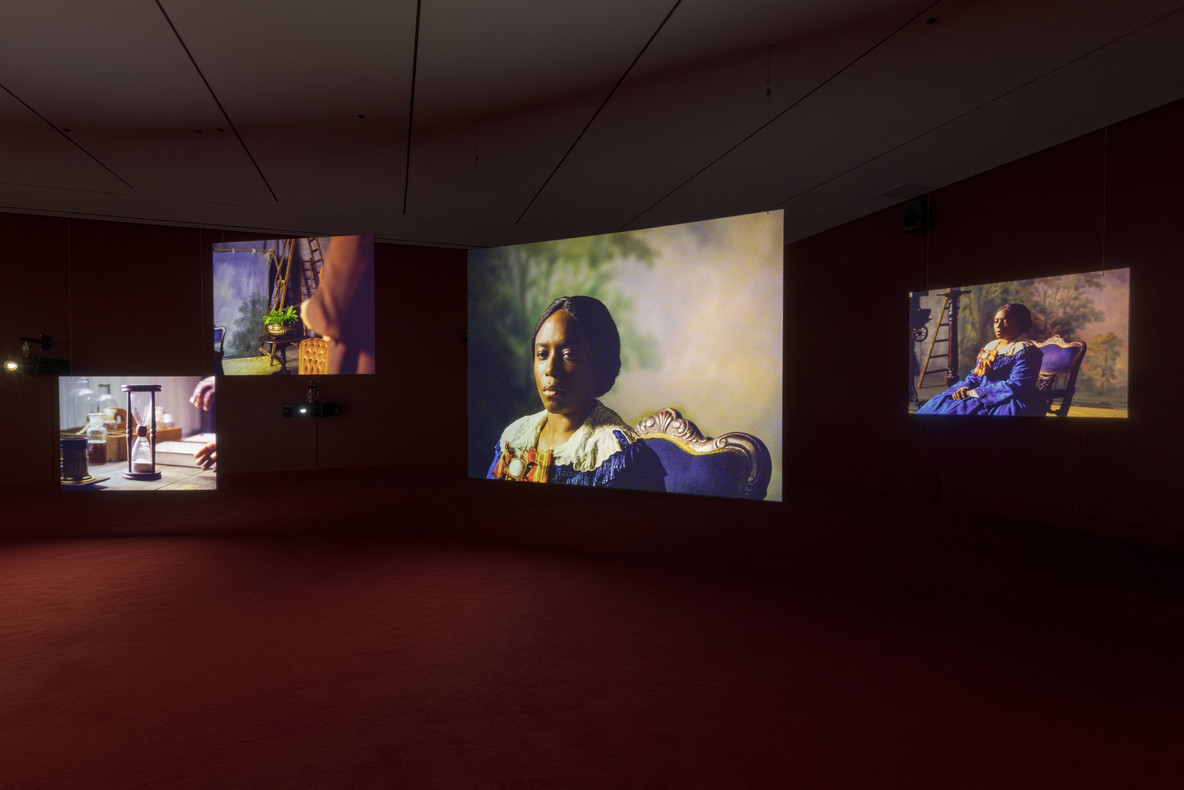
Isaac Julien: Lessons of the Hour
I think what Douglass signifies today is a reminder that these questions continue to be asked. The relationship between slavery and capital, and how they became related, and the way that things are narrativized—those are still the things being contested and ratified.
Isaac Julien
I want to ask about Douglass’s larger-than-life presence in this work. He’s the orator who dominates the film, but there’s a sense in which Douglass’s spirit inhabits the process of making the work itself. You see the grandeur and awe of Douglass, you feel it. When I look at your other films, I can see your process. But in this case, it feels like you become a kind of vessel.
I think Douglass has that effect on all of us. And I think if you’re someone who has a close relationship to his writings and speeches, it’s obviously going to happen. For example, you can tell from the performance by Ray Fearon, who plays Douglass, that he really did get transported. Douglass’s writing is also very detailed. If you go to what you might call Douglass’s man cave, in Cedar Hill, which appears in the film, you’ll see the books that he read when he was there, including the complete works of Shakespeare. He mastered that text and it comes across in his written work. So, I think there is a conjoining in this work of Ray’s performance and Douglass’s interest in language.
In the film, Baltimore functions as a place of escape for Douglass, his route to freedom. You connect this to the events of the Freddie Gray case and police brutality in the present moment. So there’s a connection between historical ideas around slavery and lynching, contemporary questions around race and representation, and structural racism, with Baltimore acting as a stage for this intersection of the past and present.
When I think about Douglass’s time and what he was struggling against, I do think there have been advancements, but I think there’s always a kind of opposing force, too. I think about a work by Adrian Piper in which she writes “everything will be taken away” on a blackboard over and over. I remember being confronted with that work, and wondering, why is she writing that time and time again? Why do they keep referencing James Baldwin in paintings? But then once I lived through 2020, I realized why.
I think what Douglass signifies today is a reminder that these questions continue to be asked. The relationship between slavery and capital, and how they became related, and the way that things are narrativized—those are still the things being contested and ratified. We continue to poetically battle with that. How can we continue to move in this necessary direction? And we have to remember that, of course, there are people who are just as determined to move things in the opposite direction. It’s an ongoing contestation.
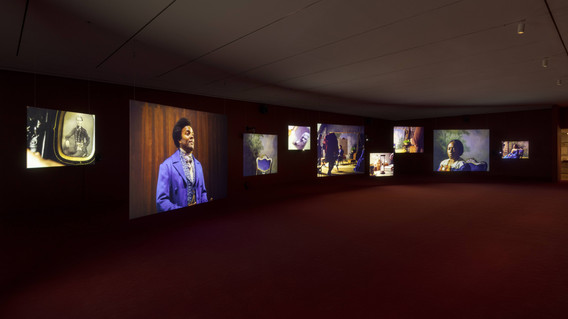
Isaac Julien: Lessons of the Hour
Isaac Julien: Lessons of the Hour is on view at MoMA through September 28, 2024.
Related articles
-
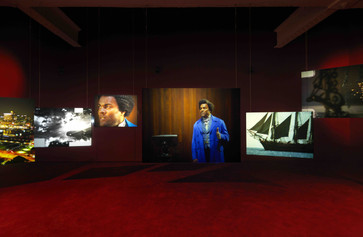
Five Things to Know about Isaac Julien’s Lessons of the Hour
Learn more about the immersive, 10-screen portrait of Frederick Douglass and the ongoing struggle to protect civil rights.
Erica DiBenedetto, Ugochukwu-Smooth C. Nzewi
May 30, 2024
-

Hyundai Card Video Views
Isaac Julien’s Looking for Langston
In this exclusive two-week screening, watch the artist’s lyrical evocation of Black queer history.
Jun 15, 2022

